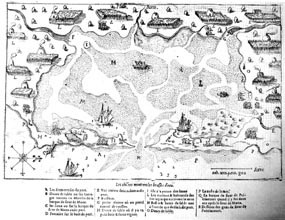
The Nauset Archaeological District, within the southern portion of Cape Cod National Seashore was one focus of substantial ancient settlement since at least 4,000 BC. Indians at Nauset Harbor practiced farming and fishing. Farming was simple, using stone hoes and fire-hardened wood tools to work the soil, but rewarding. French explorers and the early English settlers report crop surpluses. In fact, the early Pilgrim settlers purchased corn and other crop foods from the Nauset Indians during the early years of their settlement at Plymouth, just across Cape Cod Bay. One of the means of fishing can be seen in the upper right corner of the map of Nauset by Champlain (Figure 1), which shows a conical weir constructed of saplings and grass rope, designed to capture fish swimming from the marsh into a pond. Radiocarbon dating and information indicating the season in which different species were collected or hunted, based on studies of the shellfish and other faunal remains from ancient shell middens, indicate that people lived here year-round. The first written account of the area was by Samuel de Champlain, who sailed in on July 21, 1605, and saw a bay with wigwams bordering it all around. He went ashore with some of the crew: “before reaching [the Indians’] wigwams, [we] entered a field planted with Indian corn…[which] was in flower, and some five and a half feet in height. ... We saw Brazilian beans, many edible squashes…tobacco, and roots which they cultivate … .” He also described the round wigwams, covered by a thatch made of reeds, and the people’s clothing, woven from grasses, hemp, and animal skins. As the expedition cartographer, Champlain has left us an informative map of the Nauset Harbor area (Figure 1). Unfortunately, the visit to Nauset ended after four days with a fight between the French and the Indians in which one Frenchman was killed.

NPS Image When he returned the next year, Champlain recorded in his journal that about 150 people were living around Nauset Harbor and about 500-600 were living around Stage Harbor to the south in the area of present day Chatham. After 1620, English colonists from the settlement at Plymouth visited Nauset many times to buy food and trade. Unfortunately, along with the trade goods, European diseases for which the Indians had no immunity were spread by these contacts. Many of the Nauset Indians died and the population declined drastically. In 1639 about half the English from Plymouth relocated to the Nauset area, settling the town that is now Eastham. The area can be visited via the Fort Hill area, off Route 6, Eastham, where the Fort Hill and Red Maple Swamp trails wind from the top of the hill to the marsh and beyond. Visitors can view interpretive displays of the area at the Salt Pond Visitor Center at the corner of Route 6 and Nauset Road, Eastham. Additional trails from the visitor center to Coast Guard Beach pass by other ancient archaeological sites. The sites around Nauset Marsh, like most archaeological sites in the eastern part of the country, are hidden from view by soil and vegetation. This protects the sites, but it also makes it difficult for visitors to envision ancient settlements. At Nauset, the Champlain map (Figure 1) suggests how houses and cultivated fields must have filled the margins of land around the marsh in pre-European times. The view from the top of Fort Hill overlooking the modern marsh takes in all of Nauset Harbor, with its steep shorelines and extensive marsh divided by natural channels. Beyond the harbor are the breakers of the Atlantic Ocean. Nauset Beach, a barrier beach with a narrow entrance, protects the tidal lagoon. Francis P. McManamon, National Park Service |
An official website of the United States government
Here's how you know
Official websites use .gov
A
.gov website belongs to an official government
organization in the United States.
Secure .gov websites use HTTPS
A
lock (
) or https:// means you've safely connected to
the .gov website. Share sensitive information only on official,
secure websites.
